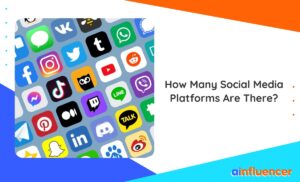Businesses consider different marketing strategies to bring more leads to their website or increase sales. Email marketing is among the most effective methods. From crafting compelling subject lines to segmenting your email list, there are various email marketing strategies that businesses can employ to create successful email campaigns.
Email marketing involves sending promotional messages, newsletters, and updates via email to subscribers who have opted in to receive communications. With the ability to reach a large audience at a low cost, email marketing has become an essential part of many businesses’ marketing strategies.
In this article, we’ll explore some of the best email marketing strategies that you can implement to take your email campaigns to the next level.
Let’s jump right in.
Best email marketing strategies
So far, we know the importance of email marketing. However, the most critical part is how to run a successful one. Like other types of marketing, email campaigns also require mindful strategies.
With a well-crafted email marketing strategy, businesses can drive conversions and build lasting relationships with their subscribers. Here are some of the top strategies to help you achieve your marketing goals:
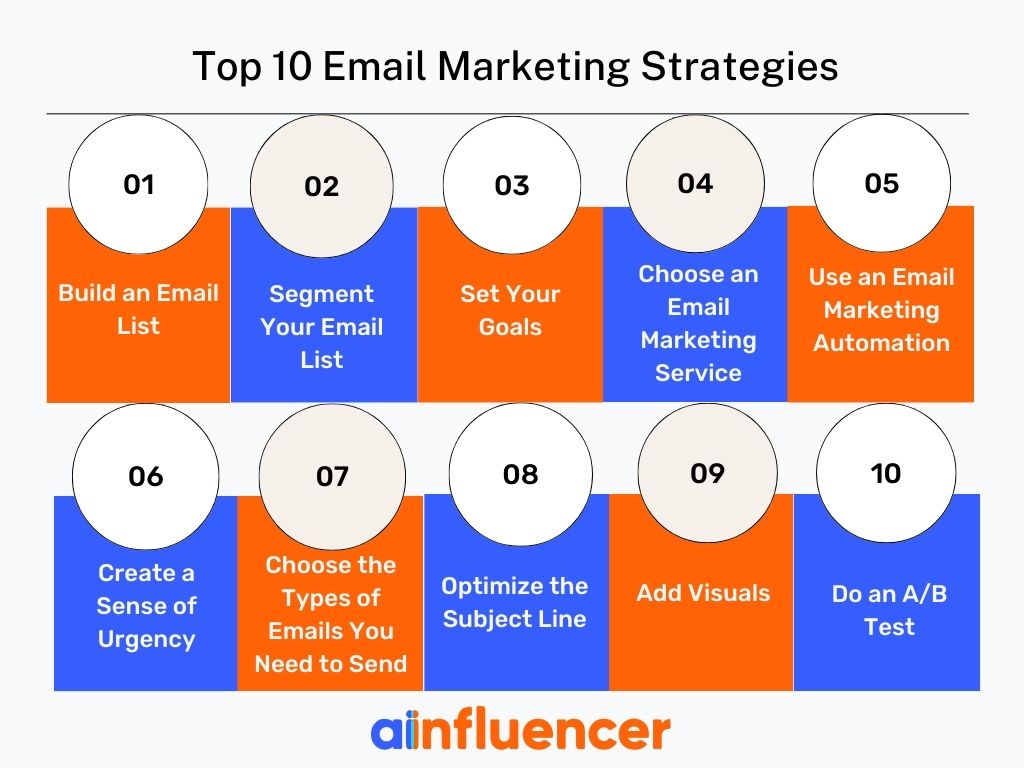
1. Build an email list
The first email marketing strategy you should follow is to build email lists. You may have an email list for your CRM; there are several things you can do to extend this list. Here are some tips:
- Ask visitors to enter their email addresses for more information or discounts. It can be a pop-up message to your homepage.
- You can make a list of anyone who signed up to your website.
- Creating a newsletter list is another great idea to upgrade your email list.
- You can also collect the email addresses of the people who purchase your products at your stores.
- There are some tools that can help you leverage your email list.
- Provide valuable content and offers to make it more appealing to your visitors to add their email addresses to your email list.
2. Segment your email list
One of the best email marketing strategies is email segmentation. What does it mean?
With email marketing tools available on the market, you can now create different email lists based on people’s behavior. For example, if some of your visitors are attracted to specific content or products, you can personalize your message by placing their email addresses in a specific group.
Although email list segmentation might be difficult, it is one of the most powerful email campaign strategies that most brands and businesses follow. That’s because they can target their visitors and give them information that is more interesting to them, making them return to your website and take action.
Segmentation can significantly improve open and click-through rates and lead to higher conversion rates.
3. Set your goals
Every email marketing campaign should have a goal. What do you want to get from this campaign? Do you want more leads? Sales? Or clicks? Setting goals is a crucial email marketing strategy that helps businesses focus their efforts and measure their success.
Like every other marketing strategy, your email marketing campaign goal should be SMART (specific, measurable, achievable, relevant, and time-bound. For example, a SMART goal for email marketing could be to increase sales by 15% within the next quarter by sending targeted campaigns to segmented audiences.It is essential to regularly monitor and evaluate your progress toward your goals and adjust your strategies as needed.
4. Choose an email marketing service
Creating email marketing campaigns is not possible without the help of email marketing services. There are lots of such services there with different features, such as email template customization or email automation. Some platforms can also help you write a more compelling subject for your email.
Choosing an email marketing service will be easier if you set the correct goal for your email marketing campaign strategy. Then, define your budget and requirements, such as the number of subscribers, the frequency of emails, and the level of automation.
Research and compare different email marketing services based on factors such as pricing, features, customer support, and integrations with other tools. You also need to consider the services’ user-friendliness, customizable templates, and reporting and analytics. Some popular email marketing services include Mailchimp and Constant Contact.
5. Use an email marketing automation
Email automation is one of the most useful features that most email marketing services offer. However, you can use marketing automation tools for this purpose. By automating your email marketing campaigns, you can save time and avoid doing repetitive tasks.
Using email marketing automation allows businesses to send targeted and timely messages. Start by identifying the different types of automated campaigns that align with your business objectives, such as welcome series, abandoned cart reminders, or birthday offers. Use triggers such as sign-ups, purchases, or clicks to send relevant and personalized messages to your subscribers.
Automation is one of the best email marketing strategies to save time and resources, improve engagement and conversion rates, and help nurture leads and customers. Make sure to test and optimize your automated campaigns regularly to improve their effectiveness.
6. Create a sense of urgency
Creating a sense of urgency is a powerful email marketing technique that can encourage subscribers to act quickly.
When people feel like they might miss out on a great deal or opportunity, they are more likely to take action. To create a sense of urgency in your email campaigns, consider the following tips:
- Use time-sensitive words, such as ‘soon’, and ‘today’.
- Add countdown timers.
- Use scarcity, such as ‘only X left’, or ‘limited edition’.
- Use exclusive promotions.
For example, you could offer a discount that expires in 24 hours, or include a countdown timer in your email that shows how much time is left to take advantage of a particular deal.
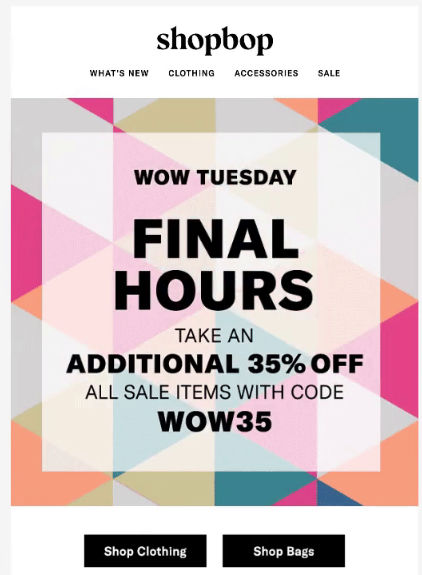
By emphasizing the benefits subscribers miss out on if they don’t act quickly, you can motivate them to take action. For instance, if you’re promoting a sale, you could emphasize that it’s a one-time offer or that stock is limited.
7. Choose the types of emails you need to send
There are various types of emails you can send as part of your email advertising campaign. Some popular types include the welcome email, the newsletter, the promotional email, the abandoned cart reminder, and the customer feedback email. Before selecting the types of emails, consider your business goals, target audience, and the stage of the customer journey. For example, a welcome email is ideal for new subscribers, while a promotional email is best for promoting a new product or service.
8. Use email marketing templates
One of the most important parts of email marketing campaigns is their layout. When people click on your email, you should lead them to what you want, and that’s possible with visually appealing email templates.
Email marketing templates are pre-designed email layouts that you can use to create an email body. Therefore, using this option can make the design process easier and faster.
Creating a professional and consistent look to your emails is one of the email marketing strategies that can even help with building brand recognition. There are several email marketing templates available online, and you can also find them in most email marketing tools or websites.
To have effective marketing emails, it is essential to select a template that fits your brand and message. Here are some tips on how to use email marketing templates effectively:
- Choose a template that suits your purpose and audience. If it’s going to be a newsletter email, add images to your content and write engaging titles and CTAs.
- Customize your template to fit your brand and message. You can present your identity with special colors.
- Test your template before sending it. Always send a preview of your email campaign to your inbox to check what your audience will see in their inbox. This way, you can make critical changes to the template and make it more engaging.
You should note that the way you present your brand in email campaigns can lead to building brand awareness.
9. Write UCG content
User-generated content (UGC) is an excellent way to build engagement and trust with your subscribers. UGC is content created by customers, such as product reviews, social media posts, and customer stories. Incorporating UGC into your email marketing strategy can improve open rates, click-through rates, and conversions.
To leverage UGC, you can ask your customers to share their experiences with your product or service and showcase the content in your emails. Additionally, you can use UGC to create social proof, which is essential to building credibility with your audience.
10. Optimize the subject line
The first thing that your audience sees while receiving an email is its subject. If it’s attractive enough, it will make them click and read the rest. Therefore, to improve email clicks and open rates, the subject line should be as engaging as possible.
Here are some tips to help you write better email subjects:
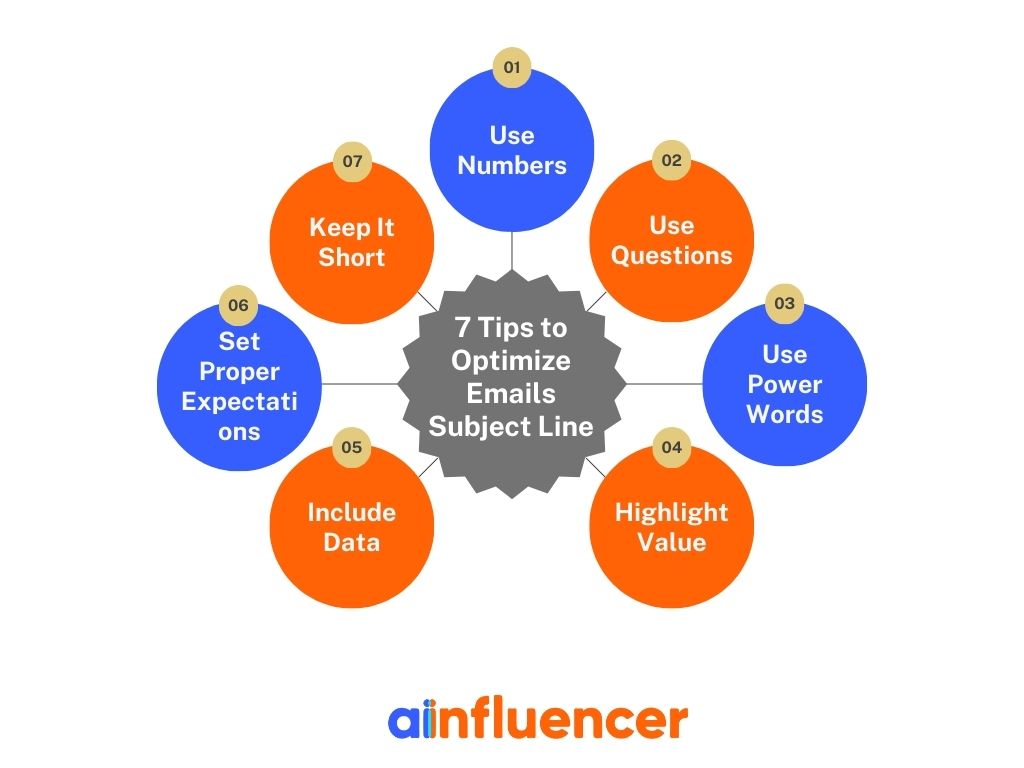
Use Numbers
Adding numbers to the subject line makes it more specific, credible, and eye-catching. They can also create a sense of urgency or value for your offer. For example, “How to Increase Your Sales by 50% in 30 Days” or “Last Chance: Save $100 on Your Next Purchase”.
Use Questions
People are curious about different subjects. Find the questions that they mostly ask and add them to your email subject line to encourage them to click to find the answer. Questions can make your subject line more interactive, personal, and relevant. For example, “Do You Know the Secret to Happiness?” or “What’s the One Thing You Need to Succeed in 2023?”.
Use Power Words
Use words that evoke strong emotions, such as excitement, fear, curiosity, or anger. They can make your subject line more appealing, persuasive, and impactful. For example, “How to Create a Killer Resume That Gets You Hired” or “The Shocking Truth About Your Health”.
Highlight Value
Your email should have a value to make people open it. Therefore, it is essential to make it clear to them what the value of this email is. For example, “How to Get More Traffic, Leads, and Sales with This Simple Strategy” or “Free Ebook: The Ultimate Guide to Email Marketing”.
Include Data
Data can add credibility and authority to your subject line. It can also show proof or evidence of your claims or results. For example, “How I Made $10,000 in One Month with This Simple Trick” or “How to Boost Your Conversion Rate by 300% with This One Tool”.
Set Proper Expectations
Your subject line should match the content and tone of your email. Therefore, avoid misleading or exaggerated claims that may disappoint or annoy your recipient. For example, “You’ve Been Selected for a Special Offer” or “You Won’t Believe What I Just Found Out”.
Keep It Short
The last but not the least important thing to consider is the length of the subject. You should note that your audience doesn’t have much time to read long and unclear topics. If it doesn’t grab their attention, they will pass. Therefore:
- Choose a concise and clear subject.
- Avoid unnecessary words or phrases that may clutter or confuse your message.
- Aim for about 6 to 10 words or 50 characters or less.
- Avoid using spam trigger words such as “free” or “limited-time offer”
- Use personalization where possible.
Remember that the subject line should be compelling enough to make the subscriber want to open the email.

11. Be concise
People may receive several emails during the day. They don’t have much time to open all of them. Therefore, they will click on clear and straightforward subjects, wanting to learn more.
Keeping your email content concise is a crucial email marketing strategy. Here are a few tips that can help you to be concise:
- Focus on the main point of your email.
- Keep your sentences and paragraphs short.
- Use bullet points to break up the content and make it more scannable.
- Avoid using jargon or complex language and instead use simple, conversational language.
Keep in mind that your goal is to provide value to your subscribers, and being concise can help you achieve this.
12. Provide value
Think about it! What makes your subscribers more eager to open your emails? There should be something in it that they want. It can be a specific subject, such as tricks or reviews, or more appealing, like discounts, a special offer, etc. Whatever it is, your email should have value to make your subscribers take their time to open and read more.
Providing value to subscribers is the foundation of all successful email marketing plans. To provide value, you need to understand your subscribers’ pain points, goals, and interests. You can do this by segmenting your email list and creating targeted content that speaks to each group. Providing value can take different forms, such as educational content, exclusive offers, or entertaining content. The key is to provide content that your subscribers find relevant and helpful.
13. Name benefits, not features
When creating your email content, it would be a better email marketing strategy if you focused on the benefits, not the features of your product or service. The benefits are what your subscribers will get from using your product or service, while the features are the characteristics of the product or service.
To name the benefits, ask yourself what problem your product or service solves and how it can make your subscribers’ lives better. Use language that speaks to your subscribers’ needs and desires and focuses on the outcomes they will achieve. By focusing on the benefits, you can be more compelling and persuasive.
14. Add visuals
Adding visuals to your email content is among the top email marketing tips. Visuals can include images, videos, GIFs, or infographics. They can help break up the text and make the content more scannable. Visuals can also help to create an emotional connection with your subscribers and make your email content more memorable. Follow these tips for adding visuals to your email more effectively:
- Choose high-quality and relevant visuals for your email.
- Optimize visuals for mobile devices.
- Select image formats that are visible on all devices, including JPG, PNG, and GIF.
- Add alt-text to your images so if the images don’t load due to internet or server issues, the recipient can better engage with the content.
- Make images clickable.
- Consider branding in your email visuals. These advertisement design tips can give ideas about branding.
- Use easy-to-read fonts. Remember that fonts are considered visual tools, too.
15. Send trigger-based campaigns
One of the most effective email marketing strategies is to send emails in response to a subscriber’s actions or behaviors, known as trigger-based campaigns.
These emails can include abandoned cart reminders or post-purchase follow-ups. Trigger-based campaigns are personalized and timely, making them more effective than generic email campaigns. Furthermore, it is one of the best email marketing techniques to engage with your subscribers and improve conversions.
To create trigger-based campaigns, you need to set up automation workflows in your email marketing tool. Overall, you can trigger emails based on various actions, such as when a subscriber opens an email or clicks on a link.
16. Personalize your emails
It’s usually more appealing to receive a message addressed specifically to you rather than a generic group email. As people are more likely to open and engage with personalized emails, doing so can increase engagement and conversions.
To personalize your emails:
- Use your subscribers’ first names in the subject line or greeting.
- Use dynamic content to display different content based on the subscriber’s interests or behavior.
Personalized emails make your subscribers feel valued and can improve the overall customer experience.
However, for this purpose, you should have different email lists, which we mentioned as the first email marketing strategy.
17. Do A/B test
You may have different subjects in mind or would like to test different layouts to see which grabs the subscribers’ attention more. That’s when A/B testing comes to help you discover what you can do to engage with your audience more.
A/B testing is an essential email marketing strategy that involves testing different elements of your email campaigns to see what works best. You can test different subject lines, email content, call-to-actions, images, and more. However, it is not something you can do manually, you should use an email marketing tool that has this feature.
You may also wonder why you would do this. It should be noted that A/B testing can help you optimize your email marketing strategies for better results.
To do A/B testing, create two versions of your email and send them to a small sample of your email list. Monitor the results and see which version performs better. Once you have a winner, send that version to the rest of your email list. A/B testing can help you have effective marketing emails over time and achieve better results.
18. Find the best times to send emails
Timing is crucial in email marketing, and finding the best times to send emails can improve your open rates and click-through rates. The best times to send emails can vary depending on your audience and industry. Generally, it’s best to avoid sending emails during weekends or late at night. Instead, try sending emails during the weekdays and during the middle of the day. You can use your email marketing tool to analyze the performance of your past emails and see when your subscribers are most engaged. Experiment with different times and see what works best for your email list.
19. Be consistent and have a schedule
Consistency is one of the other key factors you must consider in your email marketing strategy. By sending emails on a regular schedule, you can build trust with your subscribers and keep your brand on top of your subscribers’ minds.
Create an email marketing calendar and plan out your email campaigns in advance. Stick to a regular schedule, whether weekly, biweekly, or monthly.
Make sure your subscribers know when to expect your emails and avoid sending too many emails at once.
20. Use optimized call-to-actions
Ask yourself: why are you creating an email marketing campaign? What do you want your subscribers to do? It’s evident that you have put a lot of effort into creating an email that urges the reader to take action. That’s why having a clear and effective call to action is one of the most essential email marketing strategies you should remember.
Call-to-actions (CTAs) are the buttons or links in your email that encourage subscribers to take action, such as clicking through to your website or making a purchase. Optimized CTAs can improve your email conversions and drive more traffic to your website.
Here are some tips to optimize your call to action:
- Use bright colors for the buttons.
- Make words visible and legible.
- Create CTA for offers, such as %50 off.
- Keep the CTA text short but concise.
- Use action-oriented language.
Make sure your CTA is prominently displayed and easy to click on.

21. Use email signatures
One of the best techniques that can help you increase brand awareness is adding a signature at the end of the email. It is simple, yet, one of the effective email marketing strategies that almost all top brands employ.
Signatures are among great email marketing ideas to promote your brand and provide additional contact information to your subscribers. Include your name, job title, company name, and contact information, such as your phone number, email address, and social media links.
22. Include an “Unsubscribe” button
Including an ‘Unsubscribe’ button in your emails is not only a legal requirement but it’s also a good email marketing strategy. Because it gives subscribers the option to opt out of your emails if they’re no longer interested, which can improve your overall email engagement rates.
It’s better to have subscribers who are genuinely interested in your content rather than a large email list with a low engagement rate. Make sure your ‘Unsubscribe’ button is easy to find and prominent in your emails.
23. Send mobile-friendly emails
More than half of all emails are opened on mobile devices, so it’s essential for your emails to be optimized for mobile. Use a responsive design that adjusts to different screen sizes, use a legible font, and avoid long paragraphs of text. Use shorter subject lines and preheader text so that your subscribers see the most important information first. Test your emails on different mobile devices to ensure they are easy to read and navigate.
24. Leverage social media
Nowadays, it’s more fun for users to follow brands’ social media accounts and stay updated about their products and services. That’s why it’s essential to lead them to your social media accounts, where they may check more regularly than their emails.
Social media is an excellent tool for increasing your brand awareness, promoting your brand, and engaging with your audience. Use your email campaigns to promote your social media profiles and encourage subscribers to follow your accounts. You can also share your email content on social media to reach a wider audience and encourage social sharing.
Pro Tip: If you are eager to promote your brand on social media platforms, such as Instagram and TikTok, you can use influencer marketing platforms like Ainfluencer.
Take a quick overview of Ainfluencer and how it can help your business.
Ainfluencer: The Best Influencer Marketing Platform
Do you want to improve your online presence? Joining Ainfluencer has many benefits for you.
Ainfluencer is a 100% free Do-it-Yourself marketplace that connects brands and influencers on TikTok and Instagram. Brands can easily sign up on Ainfluencer, create influencer marketing campaigns for free, and invite influencers for collaboration. Furthermore, they can search for influencers based on categories, gender, location, language, hashtags, and number of followers.
Influencer marketing has never been easier than it is now with Ainfluencer.
Therefore, if you want to make a name on social media, join Ainfluencer now. Since it’s all free of charge, give it a try now.
25. Make inactive subscribers engage
Inactive subscribers are those who haven’t opened or clicked on your emails in a while. Retargeting them can be an effective email marketing strategy. Therefore, instead of deleting them from your email list, try to re-engage them by sending targeted campaigns.
You can also use a “We Miss You” email to remind them of your brand and what they’re missing. Experiment with different re-engagement campaigns and see what works best for your email list. Re-engaging inactive subscribers can improve your overall email engagement rates and prevent your emails from ending up in the spam folder.
26. Offer giveaways
One of the perfect email marketing ideas to return inactive subscribers is to offer giveaways. Offer something that’s relevant to your brand and your audience, such as a free trial or a discount code. Use an attention-grabbing subject line to promote your giveaway, and make sure the entry requirements are clear and easy to follow.
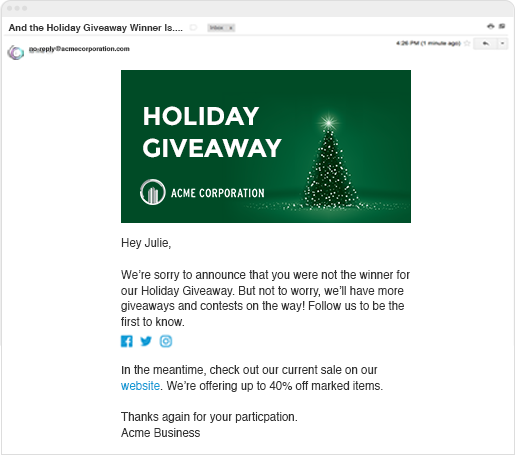
Note: Giveaway offers are always attractive for users, especially on social media. These giveaway examples can be helpful for your brand.
27. Be responsive
Being responsive to your subscribers’ needs can help you have effective marketing emails. You need to respond to their inquiries or complaints promptly and provide helpful solutions. Being responsive can help you build trust and loyalty with your subscribers, leading to higher engagement rates and conversions.
You may receive several emails during the day and might not be able to reply to all of them. In this case, the one email marketing strategy you can implement is to send an automated email acknowledging receipt and promising a follow-up the next day. Sending an email response shows that you value their message.
28. Set your marketing KPIs
Key Performance Indicators (KPIs) are measurable goals that help you track the success of your email campaigns. They can include open rates, click-through rates, conversion rates, revenue generated, and more. Set realistic and specific KPIs that align with your overall business objectives, and track them regularly. Use your KPIs to identify areas where you can improve your email campaigns and make data-driven decisions.
29. Monitor and analyze your campaigns
Monitoring and analyzing your email campaigns are among the other top email marketing strategies that can help you identify what’s working and what’s not. Use tools such as Google Analytics and email marketing software to track your KPIs and gather insights.
Analyze your data to identify trends and patterns, and use this information to optimize your email campaigns. Continuously monitor and analyze your campaigns to stay ahead of the curve and achieve your marketing goals.
30. Follow email marketing rules and regulations
Email marketing is regulated by laws such as CAN-SPAM and GDPR, which set guidelines for email marketers. You must follow these rules and regulations to avoid penalties and maintain a positive reputation.
Include an “Unsubscribe” button and your business contact information in every email, and avoid using deceptive subject lines or misleading content. Respect your subscribers’ privacy and obtain their consent before sending them marketing emails. Following email marketing rules and regulations can help you build trust and credibility with your subscribers and avoid damaging your brand’s reputation.
Conclusion
Email marketing has been a powerful and cost-effective way for businesses to reach and engage their target audience. You, as a business owner, need to identify the best email marketing strategies and implement them into your marketing campaigns in order to increase your email open and click-through rates, drive conversions and revenue, and build stronger relationships with your subscribers.
FAQs:
Email marketing is a popular and effective way to reach customers and promote products or services. There are four main types of email marketing: promotional, transactional, automated, and newsletter emails.
The first is promotional emails, which are designed to promote a product or service and encourage subscribers to make a purchase.
Transactional emails are triggered by a specific action or behavior of the subscriber, such as a purchase confirmation or a shipping notification.
Automated emails are sent out based on specific triggers, such as when a subscriber signs up for a newsletter or abandons a shopping cart.
Newsletter emails are sent on a regular basis, such as weekly or monthly, and provide subscribers with valuable content, updates, and promotions.
Each of these types of emails serves a different purpose and can be used to build and maintain a relationship with subscribers, drive sales, and improve customer engagement.
There are many marketing strategies that businesses can use to promote their products or services and reach their target audience. Three common marketing strategies are social media marketing, email marketing, and content marketing.
Social media marketing involves using social media platforms such as Facebook, Twitter, and Instagram to promote a company’s brand and engage with customers.
Email marketing involves sending promotional messages to a targeted list of email subscribers to promote products, special offers, or company news.
Content marketing focuses on creating and sharing valuable, relevant, and consistent content such as blog posts, videos, or infographics to attract and retain a clearly defined audience and drive profitable customer action.
Creating an effective email marketing strategy requires a thoughtful and systematic approach. The first step is to define your goals and objectives, such as increasing sales or growing your subscriber list. Next, you need to identify your target audience and segment your email list based on demographics, behaviors, or interests. This will help you create personalized and relevant content for each group of subscribers.
You should also consider the frequency and timing of your emails and make sure that your messaging is consistent and aligned with your brand. It’s important to measure and analyze the performance of your email campaigns regularly and make adjustments as needed. Finally, you should comply with email marketing regulations and best practices, such as providing an easy way to unsubscribe and keeping your email list up-to-date and clean.
By following these steps, you can develop a successful email marketing strategy that drives engagement, builds customer loyalty, and achieves your business goals.
Every brand follows different marketing strategies to increase brand awareness and bring more sales. Email marketing is one of the typical methods for such a purpose. The email marketing strategy is the method and set of procedures marketers identify to reach their desired marketing goal.
Creating an inbound email marketing strategy means using email marketing to attract and engage potential customers by providing them with valuable content and experiences that align with their needs and interests.
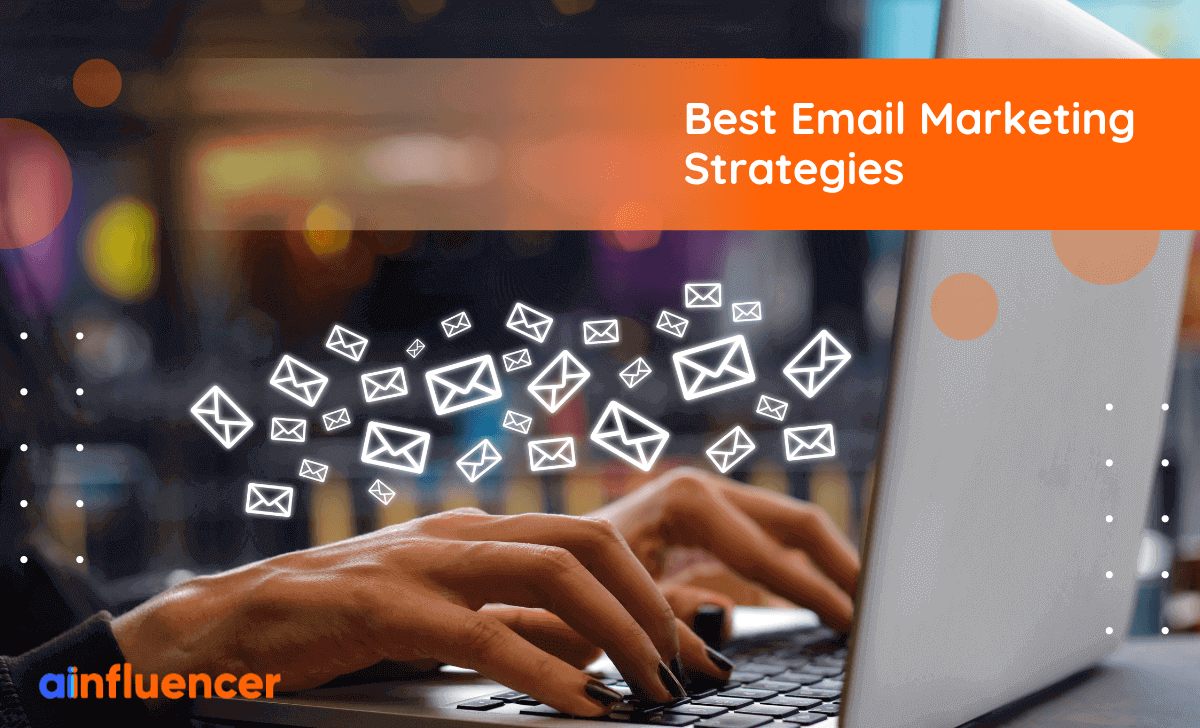

![Read more about the article How to Use ChatGPT to Make Money? [The Full Guide in 2024]](https://blog.ainfluencer.com/wp-content/uploads/2024/04/jpeg-optimizer_How-to-Use-ChatGPT-to-Make-Money-300x182.jpg)
![Read more about the article The Growth of Affiliate Marketing [2024 Update]](https://blog.ainfluencer.com/wp-content/uploads/2024/05/The-Growth-of-Affiliate-Marketing-2024-Update-300x182.jpg)


